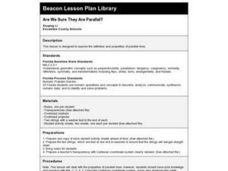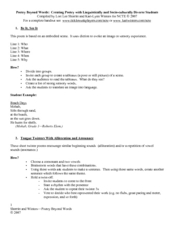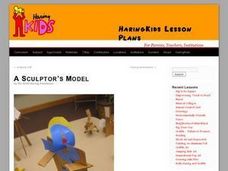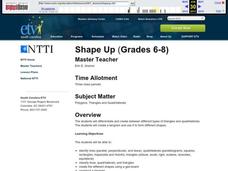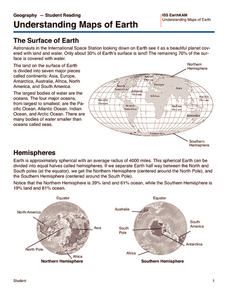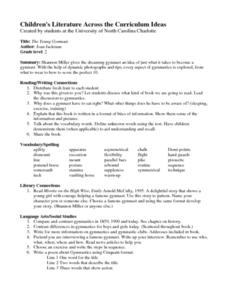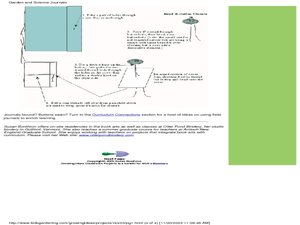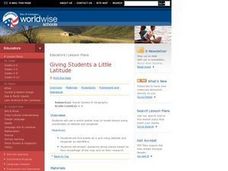Curated OER
Are We Sure They Are Parallel?
Fourth graders explore the definition and properties of parallel lines. This high level lesson has students calculate the slope of the two parallel lines, and draw the lines on a Caretsian coordinate system.
Curated OER
Series/Parallel Circuits
Young scholars engage in a lesson that is concerned with the concept of series and parallel circuits. They conduct research using a variety of resources. They have class discussion and the lesson includes information for the teacher to use.
Ohio Department of Education
I Can Name that Angle in One Measure! - Grade Eight
Collaborative groups work with geometry manipulatives to investigate conjectures about angles. They create a graphic organizer to use in summarizing relationships among angles in intersecting, perpendicular and parallel lines cut by a...
Curated OER
Dichotomous Keys
Students define the word dichotomous and explain why a dichotomous key is a useful tool in identifying different species. Then they look up words they are unfamiliar with or mollusk reference books so students can
learn the names of...
Curated OER
Declaration of Independence
Pupils analyze a copy of the Declaration of Independence to discover how it was adopted, approved, and signed. The tone and style of the document are analyzed for intention through an exploration its the language and vocabulary.
Curated OER
Poetry Beyond Words: Creating Poetry with Linguistically Diverse Students
Models of and directions for how to write 20 different types of poems are featured in an NCTE resource. The introduction to each form highlights the embedded concepts. For example, tongue twisters encourage poets to use alliteration and...
Curated OER
Plotting A Hurricane Using latitude and Longitude
Students explore map and plotting skills by tracing the movement s of hurricanes through the Earth's systems. a hurricane map is developed from daily media reports.
Curated OER
Using Magnetotactic Bacteria to Study Natural Selection
Students observe bacteria that are able to orient themselves using the Earth's magnetic field.They comprehend the difference between anaerobic and aerobic organisms. Students can tell the difference of the shape of magnetic force field...
Curated OER
Conspiracy after the Storm: Editing Dual Murder Plots in Shakespeare's 'The Tempest'
Students edit scenes from Shakespeare's The Tempest in documentary fashion and perform their edited scripts. In this play analysis lesson plan, students read through Act 2 and 3 and discuss how and why to cut lines in a play. Students...
Curated OER
A Sculptor's Model
Students investigate visual arts by researching art on the Internet. In this expressionism lesson, students identify several famous artworks on-line based on self expression and discuss the techniques. Students examine steel sculptures...
Curated OER
Heroes Portrait
Eighth graders investigate art appreciation and Renaissance portraits through time. They create a portrait.
Curated OER
Shape Up
Middle schoolers explore differents types of triangles and quadriaterals. In this polygon lesson, students model identify and compare two and three dimensional geometric figures. Middle schoolers create tangrams and discover the...
Institute for Geophysics
Understanding Maps of Earth
Here is your go-to student resource on primary geography concepts, including facts about the surface of the earth and its hemispheres, latitude and longitude, globes, types of maps, and identifying continents and oceans.
Curated OER
Exploring Geometric Figures
Tenth graders explore mathematics by participating in hands-on daily activities. Learners identify a list of different shapes and classify them by shape, size, sides and vertices. They utilize tangrams and geometric pieces to gain...
Curated OER
Age of Exploration: A Comprehensive Research Project
Fifth graders examine reasons for exploration, the outcomes, and various explorers. In this age of exploration instructional activity, 5th graders create a flipbook with timeline and images to showcase their knowledge.
Curated OER
The Young Gymnast
Second graders compare and contrast gymnastics in 1859, 1900 and today. Students contrast differences in gymnastics for boys and girls today. Students pretend that they are interviewing a famous gymnast and write up their interview....
Curated OER
Making Field Journals
Students follow a bookmaking format to create a book and use it as a garden journal. For this science journal lesson, students follow book making directions to create a garden and science journal.
Curated OER
Why Is North Korea Going At It Alone?
High schoolers examine the division of North and South Korea. They identify the ideological differences and the tensions between the two countries. They discuss the threat of nuclear weapons as well.
Curated OER
If I Could Have Lived in Another Time or Culture
Third graders develop multi-paragraph compositions. They include an introduction, first and second level support, and a conclusion. They use a variety of sentence structures (e.g., simple, compound/complex) and sentence types (i.e.,...
Curated OER
Paul Revere's Ride
Third graders read and discuss the selection "Paul Revere's Ride" (included with the lesson). Students imagine they live in one of the villages that Paul Revere stopped. They are awakened by his knock on the door. Students write an essay...
Curated OER
How Has Math Evolved?
Eighth graders pick a topic or person to research related to the history of mathematics. They brainstorm and create a concept map, using the multimedia software inspiration, about what they are researching and want to examine. They then...
Curated OER
Giving Students a Little Latitude
Young scholars use a world outline map to locate places using coordinates of latitude and longitude. They answer questions about places based on their knowledge of the map and on their research and make up more questions of this sort...
Curated OER
Walking Down Main Street: The Changing Times of a Railroad Town
Students explore the historic district via a scavenger hunt. In this community history lesson, students complete a scavenger hunt using historic postcards and clues as guides. Students create a timeline demonstrating changes of the area...
National Endowment for the Humanities
Seeing Sense in Photographs & Poems
Learners analyze photographs and poetry as forms of each other. In this poetry and photography analysis lesson, high schoolers use the photographs of Alfred Stieglitz and poetry from William Carlos William to explore how poetry and...
Other popular searches
- Parallel Lines and Angles
- Slope of Parallel Lines
- Geometry Parallel Lines
- Parallel Lines Transversals
- Properties of Parallel Lines
- Introducing Parallel Lines
- Proving Parallel Lines
- Parallel Lines Lesson Plans
- Parallel Lines and Transversal
- Systems and Parallel Lines
- Parallel Lines, Transversal
